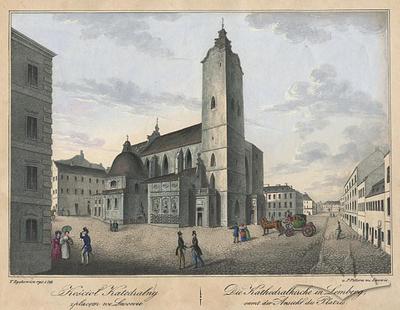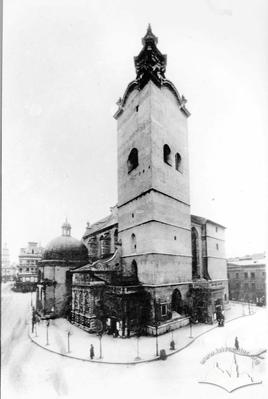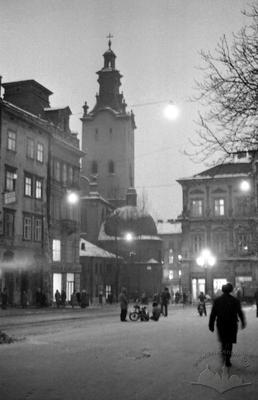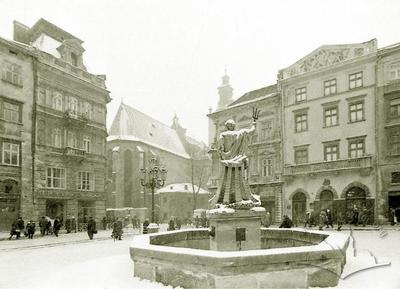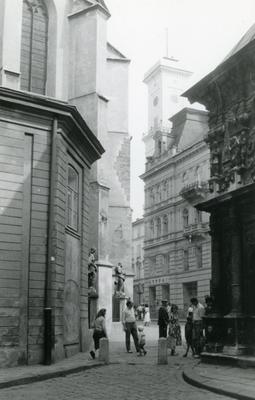Vul. Halytska, 1 – residential building ID: 1869
The building on vul. Halytska, 1 (old conscription number 227, new conscription number 239) is a corner one; its main façade overlooks pl. Rynok (number 22) while its elongated lateral façade faces vul. Halytska. It was built in 1893 on the site of the medieval Jelonkowska townhouse, the latter's cellars being used. The building is notable for its Historicist-style architecture. According to the Lviv Region Executive Committee's resolution number 130 dated 26 February 1980, the building was included in the local register of monuments (protection number 256).
Story
14th c. — a half-timbered house with stone cellars
was constructed.
16th c. — a stone
townhouse was constructed.
1781 — a boundary wall was built.
1770s — the Jelonkowska townhouse was reconstructed.
1894 — the present-day building was constructed
(architect Michał Fechter).
2012 — the woodwork of the second
floor window openings was replaced.
Halytska street was formed with the rise of the medieval city within its defensive walls. Before, it was a road or a major trade route passing via the old princely town of Lviv. After the city based on the Magdeburg Rights charter was located, the section of the road leading from the Rynok square to the southern city wall and to the gate became a street, known as Halytska, since south of the gate the street turned into a road leading to Halych. The name "Halytska" (Plathea Haliczensis) was first recorded in documents dating back to 1384. Till the second half of the 18th century it was much shorter and ended in front of the Halytska gate walls standing at the intersection with the present-day vul. Brativ Rohatyntsiv. After the demolition of the walls and ramparts the street was extended to what is now pl. Halytska. The Halytska gate, an integral and essential element of the street, served also for the communication of walled city with the outside world.
The building (old conscription number 227, new conscription number 239) stands on a corner; its main façade overlooks pl. Rynok while its elongated lateral façade faces vul. Halytska. Its history was studied by Volodymyr Vuytsyk, a noted expert in Lviv history. The present-day house was built on the site of the Jelonkowska townhouse, named after the family of Jelonki, who owned it in the mid-16th century. According to the 1767 register, its lateral façade was 54 ¼ cubits long. In 1558 the townhouse was owned by Paweł Jelonek, who, at the time of the plague which occurred that year, served as the acting burgomaster. His name is associated with a romantic story which happened in 1580. Being married and a father of two, he fell in love with Anna, a young daughter of Walenty Wilczek, a Lviv alderman. At the same time, the girl was admired by a young Italian from Florence, Urban della Ripa Ubaldini. When at the wedding of Anna Łęcka, a rich Lviv citizen, both men tried to invite Anna Wilczek to dance, the alderman's daughter preferred the energetic young Italian. Yelonek was very offended and, in a fit of jealousy, gave a slap in the face to Urban Ubaldini. In response, the Italian dealt his opponent a fatal blow with his sword. Later the Italian Ubaldini, a Florentine nobleman, who was not subject to the city court, was acquitted.
Over the years, the residents of the Jelonkowska townhouse repeatedly changed. In the 18th century it belonged to Majeranowscy and Szlechciny; a part of the building was occupied by a furrier's shop. In the second half of the 18th century the townhouse belonged to Stefan Mikulski, a canon of the Cathedral. In 1776 Mikulski sold the townhouse to Roch Karie, a jeweler, for 10 thousand guldens. In 1781 the new owner and Franciszek Nowakowski, his neighbor (conscription number 240), built a common boundary wall. Perhaps Karie rebuilt his house at the same time, because after his death in 1803 the cost of the building was already 19,980 guldens. It was then that a buttress from the side of Halytska street was mentioned, as well as one entrance to the cellar from that street and the other one from the entryway. From the side of the Rynok square the roof was hidden behind a high attic or perhaps by a pediment with three small metal banners on stone pedestals. By the end of the 19th century the townhouse had three floors and was decorated with pilasters and a richly adorned cornice between the floors. The present-day house was built in 1894 under a project designed by architect Michał Fechter and approved on 30 June 1893; on 5 January 1895 the owner was granted permission to move into the new house. In the interwar period, there was a clothing shop of Brill there; in Soviet times, the ground floor premises were occupied by a fur shop, and after 1991, by the UniCreditBank and by a fur and leather shop. In 2012 a café was arranged in the second floor premises.
Architecture
The main façade of this corner house overlooks the Rynok square (number 22) while its elongated lateral façade faces Halytska street. It is built of brick and stone on the foundations of the previous townhouse. The house has a three-part and three-tract layout and vaulted cellars; it has wooden floors, interior (from the side of the courtyard) balconies, stairs and one-storied wings. The four-storied building is covered with a tin roof.
The Historicist-style house combines Neo-Renaissance and Neo-Baroque elements; from the side of the street, it has 12 window axes and two projected wall sections, corresponding to the mansard rooms on the roof. The façade composition is characterized by a distinct horizontal segmentation. The first two floors are decorated with board rustication, the third and fourth ones have Ionic and Corinthian pilasters. At the third and fourth floor levels, there are two balconies with molded balustrades and forged railings. The windows of the lower floors are square while those of the upper floors are semicircular. The façade is crowned with a cornice on modillions.
People
Brill — a clothing shop's owner in the interwar
period
Anna
Wilczek — daughter of Walenty Wilczek, a Lviv
alderman
Walenty Wilczek —
Lviv alderman, house owner
Volodymyr Vuitsyk— art historian, expert in Lviv's history
Paweł
Jelonek — house
owner in the middle of 16th century
Jelonki —
parcel owners in the 16th century who built
the oldest house there
Roch
Karie — a
jeweler, who acquired the house in 1776 from Mikulski
Anna
Łęcka —Lviv
citizen
Majeranowscy —
house owners in the 18th century
Stefan
Mikulski — Latin
cathedral canon who owned the house in the 2nd half of 18th
century
Franciszek
Nowakowski —
owner of the neighboring house (vul. Halytska, 3) who
constructed a common boundary wall
Urban
della Ripa Ubaldini — an Italian from Florence
Michał Fechter — architect who desgined the present
building
Szlechciny — house owners in the 18th century
Sources
- State Archive of Lviv Oblast (DALO) 2/2/3666.
- DALO 2/1/1969. URL: https://e.archivelviv.gov.ua/file-viewer/228748#file-834487.
- Central State Historic Archives of Ukraine in Lviv (CDIAL), 166/1/5: 319.
- CDIAL 166/1/895: 91.
- Володимир Вуйцик, "Вулиця Галицька у Львові: кам’яниці та мешканці", Вісник інституту Укрзахідпроектреставрація, ч. 11, (Львів, 2001).
- Роман Могитич, "Ліктьовий податок", Вісник інституту Укрзахідпроектреставрація, ч. 19, (Львів, 2009)
- Łucja Charewiczowa, Czarna kamienica i jej mieszkańcy, (Lwów, 1935), 32–33.
- Ілько Лемко, В. Михалик В., Г. Бегляров, 1234 вулиці Львова (1939–2009), (Львів, 2009).











